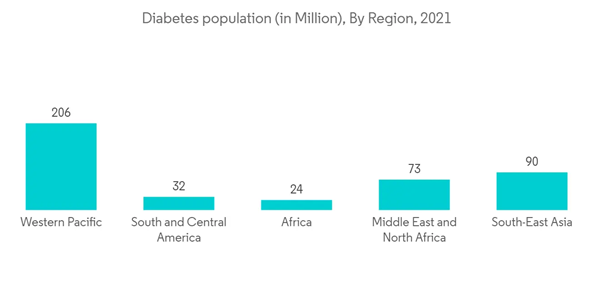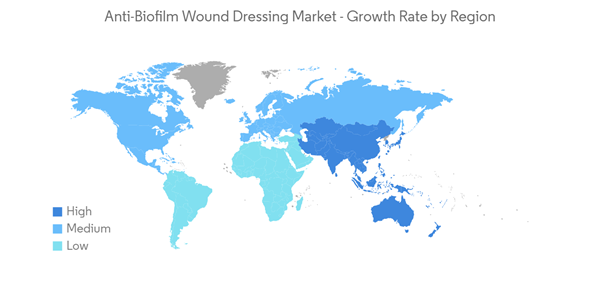Key Highlights
- The COVID-19 pandemic had a significant impact on the anti-biofilm wound dressing market as the majority of the healthcare facilities were occupied with the management of COVID-19 patients. The elective procedures were postponed during the initial phase of the lockdown, which significantly impacted wound care management. The number of patient visits reported a substantial decline during the lockdown period. According to a study conducted by Ludwig Maximilian University, Munich, Germany, around 23% of patients suffering from chronic wounds were not able to visit physicians due to the pandemic. Moreover, around 10% of respondents avoided doctor visits as a precaution.
- The increased use of telehealth in the management of chronic and acute wounds was responsible for the strong recovery of the market. Various healthcare providers developed telehealth platforms in order to effectively manage patients suffering from acute and chronic wounds. For instance, in January 2021, Wound Pros Inc. developed a telehealth platform for communication between patients and professionals. The provider also invented an app named 'RITA,' which helps in new diagnostic and wound measurement.
- The unhealed wounds caused by chronic diseases (such as diabetes, venous, or arterial disorders) show bacterial contamination film on the wound surface. The growing cases of chronic and acute wounds are expected to drive the growth of the market during the forecast period. According to the research published by National Center for Biotechnology Information in June 2022, the global prevalence of pressure ulcers is close to 12.8%, with hospital-acquired pressure injury (HAPI) accounting for 8.4% of patients.
- Moreover, the evolving healthcare infrastructure in developing countries across the globe, technological advancements in the field of wound management, and combined initiatives taken by key players and healthcare providers to increase awareness about wound care are also supporting the market's growth. For instance, in February 2022, Asep Medical Holdings Inc. announced positive outcomes related to the Antibiofilm/Anti-inflammatory Peptide Technology developed with the help of the United States Army Medical Research and Materiel Command.
- These are the key factors expected to drive the demand for advanced wound dressing solutions, including anti-biofilm products, in the near future. However, high costs associated with wound care treatment, along with the scarcity of skilled professionals, are anticipated to impede the growth of the market.
Anti-Biofilm Wound Dressing Market Trends
Chemical Segment is Expected to Witness Significant Growth Over the Forecast Period
- The chemical anti-biofilm dressing segment is anticipated to register significant growth owing to the presence of key players in the segment with iodine and ionic silver-based products, along with the rising number of patients suffering from chronic diseases. Moreover, the introduction of innovative products by major players in this segment is also responsible for the significant share of chemical anti-biofilm dressing products in the market. For instance, in November 2020, Sanara MedTech launched BIAKŌS Antimicrobial Skin and Wound Cleanser in the market. The clinical studies revealed that after the application of the product, it disrupted biofilm microbes within 72 hours.
- The increasing prevalence of chronic wounds (like venous leg ulcers, pressure ulcers, and diabetic foot ulcers) due to a surge in the prevalence of medical conditions such as diabetes is also augmenting the growth of the segment. According to the International Diabetes Federation, in 2021, more than 537 million adults were suffering from diabetes across the world. The number is likely to surpass 640 million by the end of 2030. According to the article published in Healogics, around 7 million Americans are living with a chronic wound, and it indicated an increase of 50% in amputations during the pandemic.
- Therefore, the chemical anti-biofilm dressing segment is expected to witness significant growth over the forecast period due to the introduction of innovative products and the increasing prevalence of chronic wounds.
North America is Expected to Dominate the Anti-Biofilm Wound Dressing Market
- North America is expected to dominate the market owing to factors such as the easy availability of technologically advanced products and the increasing number of wound care clinics in the region. An increase in the usage of advanced products in the healthcare facilities, such as hospitals and ambulatory surgical centers in the United States, is among the key factors which contribute to the growth of the market studied in North America. The presence of key market players such as 3M, B. Braun SE, Convatec Inc., Smith+Nephew, and Coloplast Corp in the region, along with favorable reimbursement policies, are also anticipated to drive the market.
- Increasing expenditure on the management of wounds, including pressure ulcers, is also driving the growth of the market. According to the article published by the Agency for Healthcare Research and Quality, every year, around 2.5 million patients suffer from pressure ulcers, and the cost of individual patient care ranges from USD 20,900-151,700 per patient in the United States.
- The well-developed infrastructure in the region and the increasing number of road accidents in the United States are also propelling the growth of the market in the region. According to the National Highway Traffic Safety Administration, the number of road accidents is continuously increasing in the United States. Road accidents were responsible for more than 42,000 fatalities in 2021, which reflects a 10.5% increase as compared to 38,824 fatalities reported in 2020.
- Owing to the factors such as the presence of key market players, increasing expenditure on wound management, and increasing number of road accidents, the US anti-biofilm wound dressing market is anticipated to show significant growth in North America.
Anti-Biofilm Wound Dressing Market Competitor Analysis
The anti-biofilm wound dressing market is moderately fragmented in nature due to the presence of several companies operating globally and regionally.The competitive landscape includes an analysis of a few international as well as local companies which hold large market shares and are well known, including Convatec Inc., Smith+Nephew, URGO, Coloplast Corp., 3M, B. Braun SE, Mölnlycke Health Care AB, Imbed Biosciences, Medline Industries LP, and Integra LifeSciences, among others.
Additional benefits of purchasing the report:
- The market estimate (ME) sheet in Excel format
- 3 months of analyst support
This product will be delivered within 2 business days.
Table of Contents
Companies Mentioned (Partial List)
A selection of companies mentioned in this report includes, but is not limited to:
- Convatec Inc.
- Smith+Nephew
- URGO
- Coloplast Corp.
- 3M
- B. Braun SE
- Mölnlycke Health Care AB
- Imbed Biosciences
- Medline Industries, LP
- Integra LifeSciences










